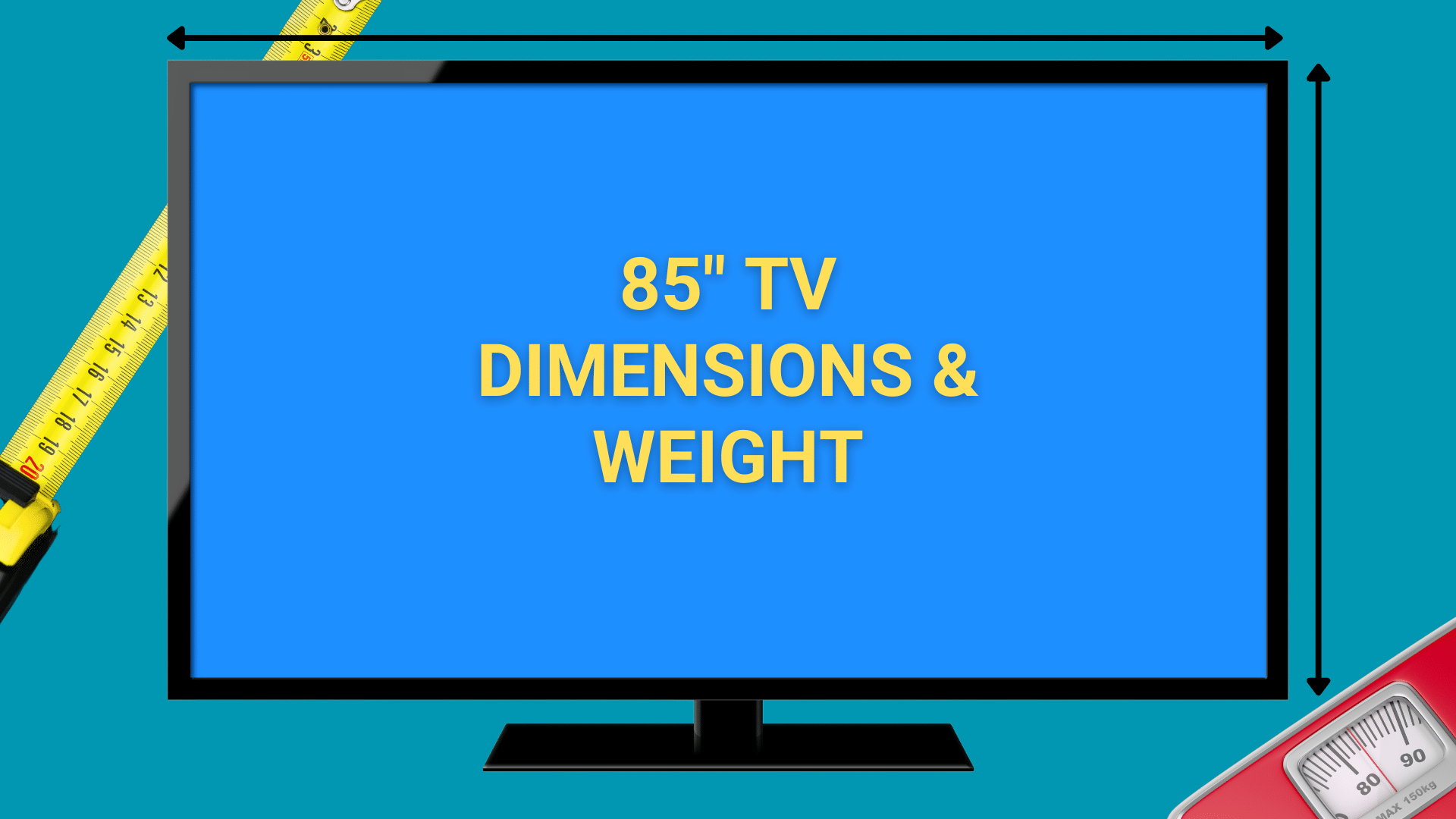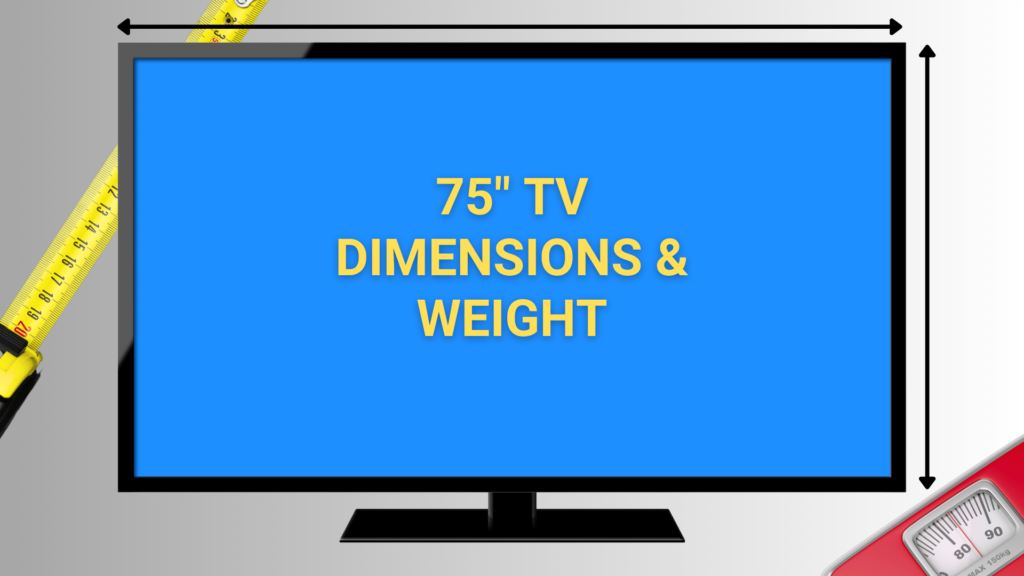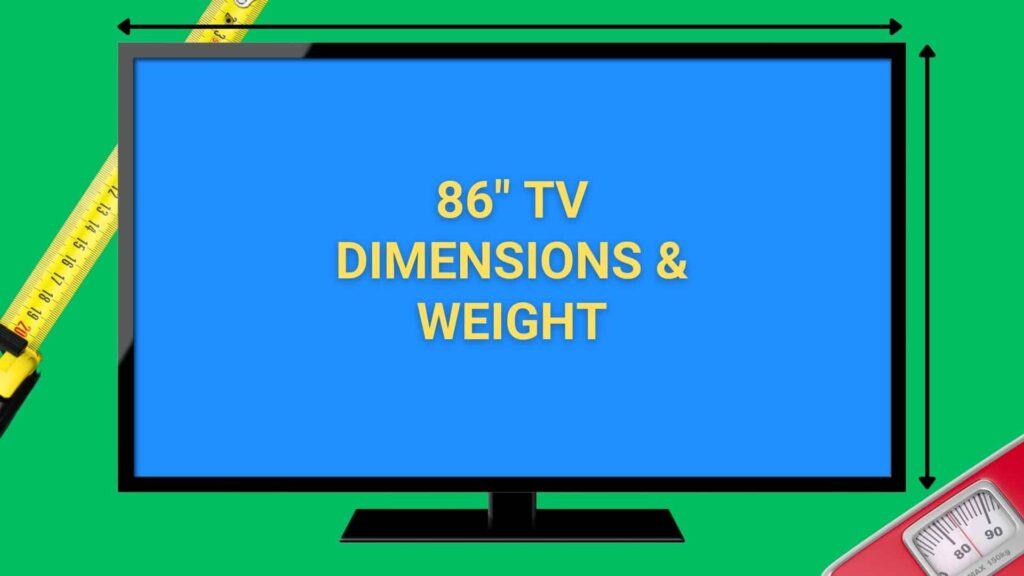Choosing a large television for your home is an exciting decision, but it’s also essential to think about the dimensions and weight.
In this article, we’ll dive into the average 85 inch TV dimensions and weight, as well as the best viewing distances and mounting heights for a fantastic viewing experience.
How Big Is An 85 inch TV? – Average Dimensions
On average, you can expect an 85-inch TV to be about 74.7 inches (189.8cm) wide, 42.7 inches (108.4cm) tall, and 2 inches (5.1cm) without a stand.
With a stand, the average height jumps to 45.6 inches. As for the depth, an 85-inch TV is typically around 2.0 inches deep without a stand and approximately 14.7 inches deep with a stand.

Table of Contents
Thinnest 85 inch TV
The Saumsung 85″ QN900B Neo QLED 8K Smart TV (2022) clocks in as the thinnest tv in the 85″ size class at only 0.7 inches (1.8 cm) thick. It also has the smallest overall size at 73.9 inches (187.7 cm) wide and 42.2 inches (107.2 cm) tall without the stand.
How Wide is a 85 Inch TV?
So, how wide is an 85-inch TV? The average width of an 85-inch TV is roughly 74.7 inches.
Keep in mind that the exact width may vary depending on the brand and model of the TV you choose.
How Much Does a 85 Inch TV Weigh?
When it comes to weight, an 85-inch TV usually tips the scales at about 94.7 lbs without a stand.
With a stand, the average weight increases to 106.0 lbs.
Remember, the actual weight of a specific TV model could differ slightly depending on the brand and additional features.
Average 85-inch TV Size & Weight Without Stand by Manufacturer
| TV Size & Brand | Unique Models Researched | Average Width Without Stand (inches) | Average Height Without Stand (inches) | Average Depth Without Stand (inches) | Average Weight Without Stand (lbs) |
| 85″ TVs Overall | 27 | 74.7 | 42.7 | 2.0 | 94.7 |
| Hisense | 1 | 74.9 | 42.8 | 3.5 | 90.4 |
| Samsung | 19 | 74.6 | 42.6 | 1.3 | 93.7 |
| TCL | 7 | 74.8 | 43.0 | 3.6 | 97.9 |
Average 85-inch TV With Stand – Sizes & Weights by Manufacturer
| TV Size & Brand | Unique Models Researched | Average Width With Stand (inches) | Average Height With Stand (inches) | Average Depth With Stand (inches) | Average Weight With Stand (lbs) |
| 85″ TVs Overall | 27 | 74.7 | 45.6 | 14.7 | 106.0 |
| Hisense | 1 | 74.9 | 46.6 | 18.7 | 95.7 |
| Samsung | 19 | 74.6 | 45.3 | 13.9 | 107.6 |
| TCL | 7 | 74.9 | 46.5 | 16.4 | 103.2 |
| Grand Total | 27 | 74.7 | 45.6 | 14.7 | 106.0 |
Related Articles
Finding the Best Viewing Distance for a 4K 85″ TV – Minimum Room Size
Now let’s talk about the best viewing distance for a 4K UHD 85-inch TV.
The sweet spot is usually between 10.6 and 14.2 feet. Within this range, you can fully enjoy the benefits of 4K resolution while minimizing any potential eye strain.
What is the Best Viewing Distance for an 8K 85″ TV?
If you’re looking to go all out with an 8K UHD 85-inch TV, the optimal viewing distance is about 6.8 to 10.6 feet.
At this distance, you’ll be able to appreciate the incredible detail of 8K resolution without causing any discomfort or strain to your eyes.
How High Should a 85″ TV Be Mounted?
The perfect mounting height for an 85-inch TV is around 42 inches from the floor to the center of the TV screen.
This height places the TV at just the right viewing angle for most people sitting down, reducing neck and eye strain.
However, don’t forget to consider your room’s specific seating arrangement and adjust the height accordingly for the best possible viewing experience.
Why Is TV Size Measured Diagonally?
TV sizes are measured diagonally because it provides a single number that represents the overall size, making it easier to compare different TVs.
The diagonal measurement runs from one corner of the screen to the opposite corner, and with the aspect ratio (16:9), it conveys both the width and the height of the screen.
How Much Bigger is a 85-inch TV vs a 75-inch TV?
An 85-inch TV is about 13% larger diagonally than a 75-inch TV.
In terms of screen area, an 85-inch TV has roughly 27% more screen space than a 75-inch TV.
This difference in size can significantly enhance the viewing experience, especially when considering factors like viewing distance and room size.
How big is a 85-inch TV in centimeters?
A flat panel TV in the 85-inch size class measures approximately 216 centimeters diagonally.
On average, these TVs have a width of 189.8 cm, a height of 108.4 cm without a stand, and a depth of 5.1 cm without a stand.
FAQ’s
-
What are the dimensions of a 85-inch Samsung TV?
Samsung 85″ inch TV dimensions vary depending on the specific model.
On average, the width is around 74.6 inches (189.5 cm) and the height is approximately 42.6 inches (108.2 cm) without a stand.
-
Are all 85-inch TVs the same dimensions?
No, 85-inch TVs do not all have the same dimensions. The width, height, and depth can vary depending on the brand, model, and bezel size. However, the screen size (measured diagonally) will remain the same at 85 inches.
-
How big should my TV be if I sit 12 feet away?
If you sit 12 feet (144 inches) away from your TV, a 75- to 85-inch TV with a 4K UHD resolution is ideal, as the recommended viewing distance for such TVs is approximately 9.5 to 14.2 feet.
-
Does the weight of a TV affect the type of wall mount I need?
Yes, the weight of a TV plays a crucial role in selecting the appropriate wall mount. It is essential to choose a wall mount that can safely support the weight of your TV. Always check the maximum weight capacity of a wall mount before purchasing.
-
How do aspect ratios affect TV dimensions and screen sizes?
Aspect ratios, such as 16:9, represent the relationship between the width and height of a TV screen. The aspect ratio, combined with the screen size, is the main determining factor in the overall size of a TV, including the bezel surrounding the screen.
-
Do TV bezels affect the overall dimensions of a TV?
Yes, TV bezels can affect the overall dimensions of a TV. Thicker bezels may add to the width and height, while thinner bezels can create a more seamless appearance. When considering the dimensions of a TV, it’s important to take the bezel size into account.
-
Is there a weight difference between LED, OLED, and QLED Televisions?
Yes, there can be a weight difference between LED, OLED, and QLED TVs.
Generally, OLED TVs tend to be lighter than LED and QLED TVs of the same screen size because they have a thinner panel design and don’t require a backlight.
QLED TVs are often slightly heavier than regular LED TVs, as they use additional layers of quantum dots in their panel construction. However, the exact weight difference can vary depending on the brand, model, and additional features of each TV.
Wrap Up
Understanding the dimensions and weight of an 85-inch TV, as well as the optimal viewing distance and mounting height, is essential for finding the perfect TV for your space.
The average dimensions of an 85-inch TV including the bezel (or frame) are 74.7 inches in width and 42.7 inches in height, without a stand.
Keep in mind that the weight and overall dimensions can vary based on factors like brand, model, and bezel size. As you consider these factors, you’ll be well on your way to choosing the ideal 85-inch TV for an immersive and enjoyable viewing experience in your home.

